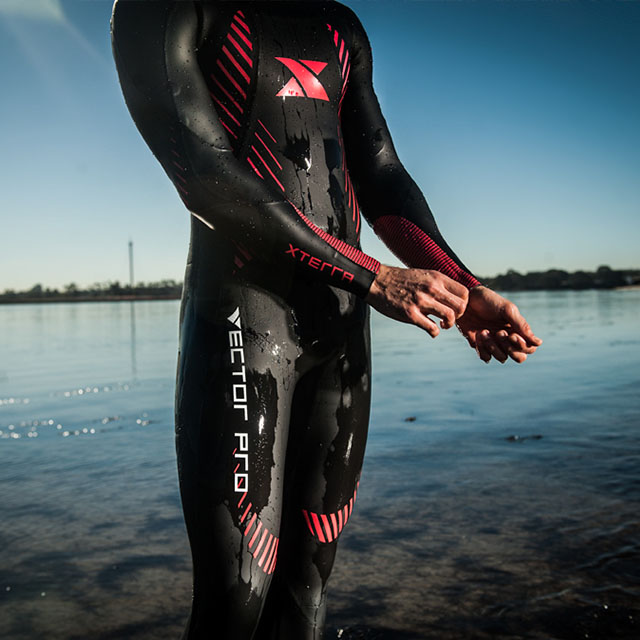Full-sleeved suit vs. Sleeveless
In the triathlon world, there are two styles of wetsuits: full sleeved and sleeveless (also called “john”). Both wetsuits have full leg covering and come in a variety of thicknesses (though you won’t find any that are thicker than 5mm due to USAT rules). The thinner the shoulders are in a fullsuit, or increased number of panels, the more range of motion you will have for your arms and reduction of arm fatigue.
There are several factors to consider when deciding on which style to purchase. You will want to consider:
- water temperature and acclimation to that temperature;
- distance of your practice swims, and race (Which will help you understand time you’ll be in the water); and
- experience as a swimmer.
WATER TEMP- When looking at the temperature of the water, and the time you will be in the water, it is always important to factor the comfort level in the water. If you’re a slower swimmer, you will be swimming for a longer period of time than a faster swimmer, and thus be subject to the water temperature for more time. If you get cold easily as a slower swimmer, a full-sleeved suit will be a better choice so that you’re able to enjoy more of the swim.
DISTANCE- As a triathlete of 8 years, I have not spent the hours that my more experienced colleagues have. As such I am not as comfortable in cooler water. Taking my slower speed, moderate distance swims, and lower tolerance of cooler water, I stick with a full-sleeved suit. Some of my faster coworkers will wear a sleeveless wetsuit because of their speed, and comfort in cooler water.
EXPERIENCE- Due to increased surface area, as well as buoyancy, a full-sleeved wetsuit is typically faster. If your goal is to go as fast as possible, a fullsuit will get you across the finish line faster. Pro triathletes almost always wear a full-sleeved wetsuit, and there is a reason for that!
Sizing your wetsuit
Sizing charts for wetsuits typically are not based on clothing sizes, but rather height and weight. If you have a longer torso, broad shoulders, or a more muscular build, there might be variances in your weight that the initial chart doesn’t account for.
Below is an example of sizing chart, with both men’s and women’s sizing:
When looking at sizing your wetsuit, in addition to the sizing chart, you will want to consider how tight you are comfortable with clothing fitting. Wetsuits will stretch up to half a size because of the flexibility of the materials used. Your wetsuit should take at least five minutes to put on and should feel very snug. If you are right on the border of a suit, and less comfortable with tight fitting, sizing to the larger size will likely be a great match. If the suit is too large, then in addition to pulling yourself through the water, you’ll be pulling additional water. If possible, swim in two different wetsuits (with two different models or brands) to see if you have the right fit.
Putting on a wetsuit

Start by having the wetsuit entirely inside out. With the rubber on the inside, and the liner on the outside, you’ll be able to roll the suit on.”
- With the suit inside out, ensure that you are looking at the chest, not the back zipper, as you hold it up.
- Lay the suit on the ground in front of you and insert your feet through each opening. Begin to tug the suit up over your lower legs, working evenly and alternatively from leg to leg.
- Once you have the suit up and over your chest, do one arm at a time in the same manner (with it inside out). This will avoid putting undue stress on the suit and ensure that the outside rubber coating keeps from getting fingernail tears.
Maintaining a wetsuit
Once you’ve chosen the perfect wetsuit, you want properly maintain it so it lasts a few seasons.
Wetsuits are fragile because the coasting on the neoprene is designed to make you go fast, but unfortunately sacrifices durability. If cared for, they will last you for many swims, but this includes airing them out to dry in a controlled environment. After swimming in open water, it is best to rinse off the suit and then set it to dry inside out so that the liner and neoprene can dry. A few things when caring for your wetsuit:
- Never leave it out in the sun, or in your hot car to dry, especially inside out (or the rubber will melt).
- Never place your suit in the washing machine to clean it, or the dryer
- Never leave the suit bunched up, limiting air flow
You’ll want to hang it up to dry, and keep it in a cool, dry and dark place (out of sunlight). Once the wetsuit is dry, you will want to hang it up with a plastic hanger without sharp edges. This will allow for constant airflow to the suit.
Following these tips to getting into your wetsuit and maintaining it will ensure that the suit and you have many happy swims together!





